Everything You Need to Know about a Self-Directed SEP IRA
What is a Self-Directed SEP IRA, and how might it make sense to direct one yourself? A SEP IRA is a “pension plan” for employers that self-employers sometimes use to manage their own retirement accounts. But if you want to make the most of a SEP IRA, it helps to know the ins and outs. How do these accounts work, and who might they most benefit? Let’s explore the Self-Directed SEP IRA and all its benefits:
The Tax Benefits of a Self-Directed SEP IRA
Here are some of the most immediate tax benefits of using a Self-Directed SEP IRA:
- Tax-deductible contributions. When you make contributions on behalf of eligible employees, the company can deduct these contributions. For a self-employed individual, that means that it’s also easy to make tax-deductible contributions.
- Tax-deferred earnings. With money in a Self-Directed SEP IRA, investors will enjoy tax-deferred growth. The earnings can then compound within the account, with taxes only paid upon taking money out of the account.
- High contribution limits. One of the chief benefits of the SEP IRA is that it uses large contribution limits, which can include the lesser of either $56,000 or 25% of the participant’s compensation for 2019.
- It only takes IRS Form 5305-SEP and giving each eligible employee a copy for someone to establish a SEP IRA. However, keep in mind that a Self-Directed SEP IRA for an individual like a sole proprietor might want to double check with a Self-Directed IRA administration firm to make sure everything goes smoothly. Otherwise, the SEP IRA is one of the most simple and convenient ways to set aside money for retirement, not requiring lengthy tax forms.
Another note on simplicity: the SEP IRA works much like a Traditional IRA when it comes to rules like rollovers, funding, and the like. Using a Self-Directed SEP IRA, an individual will be able to put money away for retirement that can be deducted on the year’s taxes, assuming that all of the rules have been followed. This is a simple setup for self-employed individuals who simply want to sock away more money and use the tax-deferred benefits of a retirement account to enjoy more of their own income with tax deductions.
Should You Sign Up for a Self-Directed SEP IRA?
Given what we know about Self-Directed SEP IRAs here, to whom does an account like this most make sense?
It’s a popular option for freelancers and sole proprietors. These individuals need to maximize every dollar of income to ensure that they do not run into any money issues, especially given the irregular nature of their income. For that reason, putting money in a SEP IRA means tax-deferred growth that lightens the load when it comes tax time.
For those people who want to enjoy a large income in the present and anticipate that they’ll be in a smaller tax bracket come retirement, the tax-deferred nature of the SEP IRA can also be a benefit. It helps you enjoy the rest of your money now while putting aside some for retirement.
As for Self-Directing a SEP IRA, it opens up plenty of options for people who are off the beaten path of investing. They can use the high contribution limits in a SEP IRA to make investments in real estate, precious metals, and more. This allows people to diversify their assets and feel much more secure about their retirement no matter what’s going on in the economy. And with the higher contribution limits in place, it allows people to put more of their money aside for tax-deferred growth, which has the benefit of increasing net worth far more efficiently.
Interested in learning more about Self-Directed IRAs? Contact American IRA, LLC at 866-7500-IRA (472) for a free consultation. Download our free guides or visit us online at www.AmericanIRA.com.










